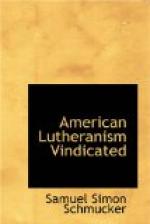The Plea affirms that the primitive church regarded the sacraments as “mysteries;” p. 37. But the author presents no evidence of this fact from God’s word, or the apostolic church; and the church of subsequent ages is no conclusive doctrinal authority for us as Protestants.
The Plea states: “He (God) is able to accomplish by the Holy Baptism, performed in the mysterious name of the ever adored Trinity, a work of regeneration in the heart of the little child.” “The expression used in the Augsburg Confession, Art. II., is, regenerated by baptism and the Holy Ghost, (John iii. 5.) This doctrine, however, is not to be understood as if the new creation was fully completed by new generation. It is complete so far as a live seed is complete in itself. This does, by no means, exclude subsequent development brought about by favorable internal and external influences;” p. 36. “And Christ, the Godman, is able to make us poor earthly creatures partakers of his celestial nature_, (2 Pet. i. 4,) in the most solemn rite of his church, (the eucharist,) which is therefore communion between Christ and man, in the fullest manner possible on earth;” p. 37. Here the respected author, by adopting the theory that a living seed is implanted by baptism, (whether into the soul or body he does not specify,) and then that the Godman Christ Jesus makes these baptized individuals partakers of his CELESTIAL NATURE by the sacramental supper, seems to favor something like that theory of concorporation, or a physical union between Christ and the believer, which is known in various phases as Puseyism in England, and Nevinism in the German Reformed Church of this country, and which has spread a withering influence over the interests of practical piety wherever embraced. Yet we would by no means affirm that the Rev. Mr. Mann has embraced all the cardinal features of this system. The objection that is fatal to it in our mind is, that we cannot find it in God’s word. [Note 1]
We shall therefore proceed to ascertain the Scripture doctrine in regard to the influence of the sacraments in general. For the sake of brevity and perspicuity, we shall present it in a concatenation of propositions, that in the end will cover the whole ground, and conduct us safely to the surest biblical results.




